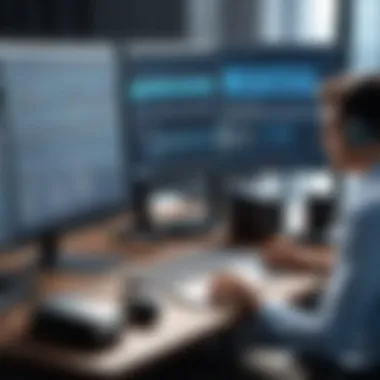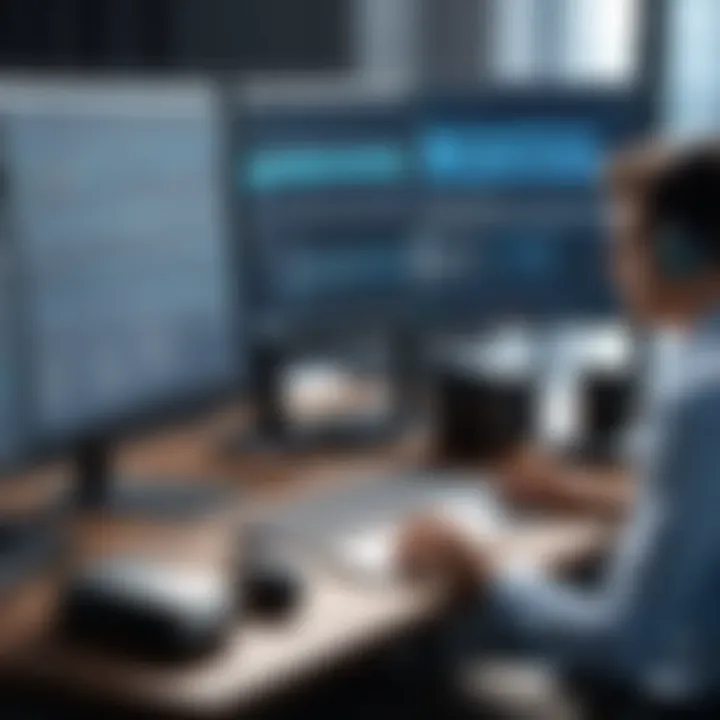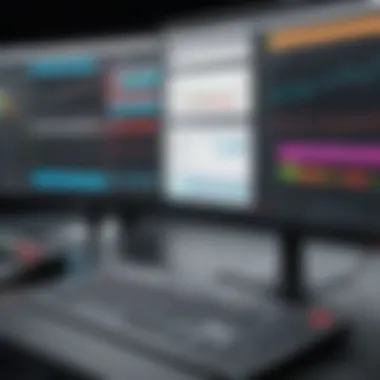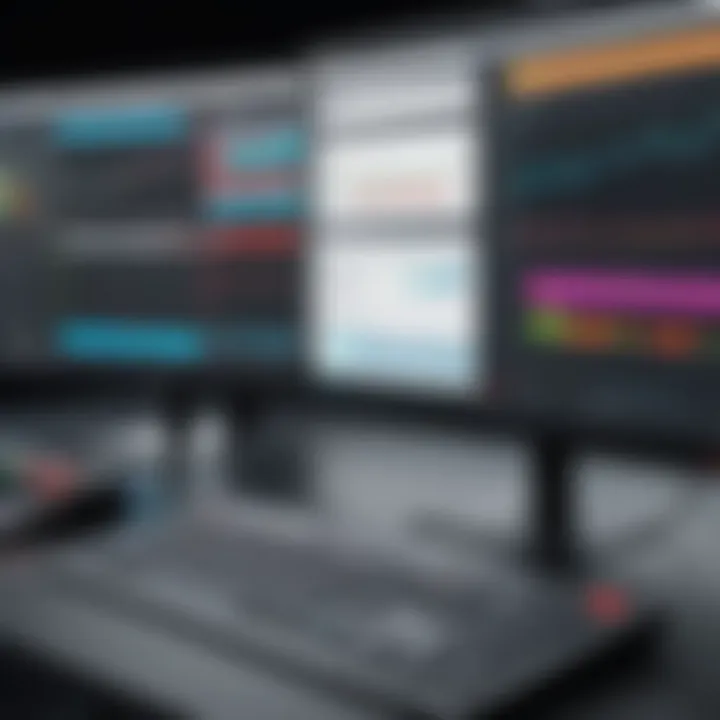In-Depth Review of Screen Recorder Editors


Intro
In a digitized era where content creation thrives, screen recorder editors have emerged as pivotal tools. Their role extends beyond merely capturing on-screen activity; they facilitate the editing and refinement of recorded videos. This is particularly beneficial for both individual users and businesses needing to produce training materials, demonstrations, or engaging tutorials. As workplaces evolve to accommodate remote and hybrid models, understanding different screen recorder editors becomes increasingly relevant.
This article will explore various aspects of screen recorder editors, capturing their key features, benefits, and limitations. Users will gain insights on notable software options available in the market today, alongside comparisons that will assist in making informed decisions aligned with specific needs.
Brief Description
Overview of the software
Screen recorder editors are software applications designed to capture and edit video content directly from the screen. These tools allow for a seamless recording experience, enabling users to document processes, create how-to videos, and more. Typically, they offer functionalities for recording the entire screen, a selected region, or specific application windows. Editing capabilities often follow, allowing users to trim, annotate, and enhance their recordings, elevating the overall quality of the output.
Key features and functionalities
Key features commonly found in screen recorder editors include:
- Flexible recording options: Users can choose to record full screens, selected areas, or specific application windows, providing versatility in capturing content.
- Editing tools: Most software includes basic editing tools to trim, cut, or merge video clips. Advanced options may also allow users to add text, transitions, or effects.
- Audio capture: Many screen recorders can record system audio, microphone input, or both, enhancing the quality of instructional videos.
- Export options: Support for various file formats and direct sharing capabilities to platforms reinforce the tool's convenience.
- Customization: Features like webcam overlays or annotation tools empower users to personalize and emphasize points of interest in their videos.
"Screen recording technology has revolutionized how tutorials and training materials are produced, offering unprecedented accessibility while maintaining clarity and engagement."
System Requirements
Hardware requirements
To run screen recorder editors efficiently, certain hardware specifications are recommended, such as:
- Processor: A multi-core processor (Intel i5 or equivalent) is advisable, particularly for high-resolution recording.
- RAM: At least 8 GB of RAM is suggested to facilitate smooth operation, with minimal lag during heavy video processing tasks.
- Storage: Ample storage space is necessary to accommodate large video files, especially if recording at high resolutions.
Software compatibility
When selecting a screen recorder editor, compatibility with operating systems is crucial. Most modern applications support:
- Windows: Typically, versions ranging from Windows 7 or above.
- macOS: Generally compatible with the latest macOS releases.
- Linux: Some applications offer support for various distributions, but functionality may vary.
Understanding these requirements helps users choose a screen recorder editor that aligns not only with their technical capacity but also with their unique video creation needs.
Foreword to Screen Recorder Editors
Screen recorder editors represent a significant intersection of technology and user creativity. In an age where digital content is paramount, the ability to capture, edit, and present visual information effectively cannot be overstated. The importance of understanding screen recorder editors lies in their diverse applications, from education to business presentations, and even entertainment.
These tools allow users to seamlessly capture what happens on their screens, enabling an engaging way to convey information. An educator can create instructional videos with ease, while businesses can document processes or host virtual meetings with visual aids. This capability extends beyond mere recording; editing features are integral for refining content to meet specific audience needs.
Choosing the right screen recorder editor involves careful consideration of several elements. Factors such as recording quality, available editing tools, usability, and pricing are crucial. A well-chosen editor not only facilitates ease of content creation but also improves the overall quality of output, making it more appealing to viewers. Many professionals and organizations look for software that strikes a balance between functionality and user-friendliness, ensuring that even those with limited technical skills can create high-quality content.
In summary, the exploration of screen recorder editors is essential for anyone involved in producing digital content. Understanding their functionalities, strengths, and weaknesses will empower users to select the most suitable tools for their specific requirements. As we delve deeper into this subject, the forthcoming sections will outline the historical context, the purpose of screen recording, and the critical features to evaluate.
Understanding Screen Recording
Screen recording has evolved into a critical tool in numerous sectors such as education, business, and content creation. Understanding the fundamentals of screen recording is essential for anyone looking to utilize this technology effectively. It encompasses several elements, including the software involved, the formats of the recordings, and the implications of different usage scenarios.
What Is Screen Recording?
Screen recording is the process of capturing the display output of a computer or mobile device in real-time. This digital recording can include everything from video tutorials, gameplay sessions, webinars, and much more. The output is typically saved in a digital video format. Common formats include MP4, AVI, and MOV, among many others. Screen recording can benefit users by allowing them to create explanatory videos which are particularly useful for teaching purposes.
Benefits of screen recording include:
- Visual Learning: Helps convey complex information in an understandable way.
- Time Efficiency: Record once, use repeatedly.
- Accessibility: Allows users to access content at their own pace.
Historical Context of Screen Recording
The origins of screen recording can be traced back to the early days of computer technology. Initially, the concept was limited to capturing static images or simple demonstrations. Over the years, as technology advanced, so too did the capabilities of screen recording software. The introduction of more powerful graphics processing units (GPUs) and improved coding methods led to higher quality video captures and more user-friendly interfaces.
In the late 1990s and early 2000s, software like Camtasia and Snagit started to popularize the idea of capturing both audio and video together, enhancing the learning experiences in educational contexts. As high-speed internet became readily available, sharing these recordings became easier, leading to their widespread adoption for business presentations and online tutorials. This historical overview illustrates how screen recording not only reflects technological advancements but also transforms how we communicate and share information digitally.
Purpose and Applications of Screen Recorders
Screen recorders serve various purposes across multiple domains. Understanding their applications is critical for anyone looking to utilize screen recording technology effectively. The core benefits include enhanced communication, streamlined workflows, and improved learning experiences. Each application demonstrates how screen recording tools can address specific needs and challenges.
Educational Uses
In education, screen recorders become powerful instruments for both teachers and students. Educators can create engaging tutorials that simplify complex topics. For instance, a math teacher can record a step-by-step calculation process, allowing students to revisit the content at their own pace. This flexibility aids in reinforcing learning.
Moreover, screen recorders support distance education. The growing trend towards remote learning emphasizes the need for tools that facilitate interactive lectures and visual presentations. Students can benefit from recorded lectures, which provide an accessible archive of classroom content.
Business and Professional Contexts
Within business environments, screen recording software enhances collaboration and training. Organizations use these tools to create training videos for new employees, allowing them to understand processes without needing one-on-one guidance. This saves time and resources, making onboarding more efficient.


Additionally, project updates and presentations can be recorded to communicate progress or feedback effectively. Asynchronous communication becomes seamless. Employees can digest information on their own schedules, leading to improved efficiency.
Creative and Entertainment Purposes
In the realm of creativity and entertainment, screen recorders enable content creators to produce engaging material. Streamers on platforms like Twitch and YouTube rely on these tools to capture their gameplay. They can then edit and share these recordings, offering their audiences insights into games while building their personal brands.
Furthermore, digital artists often use screen recording to document their creative process. This documentation not only serves as a portfolio piece but also as educational content for aspiring artists who wish to grasp techniques and approaches in digital artistry.
Screen recording technology has transformed how individuals and organizations communicate, learn, and create. Its versatility caters to diverse needs across educational, professional, and creative landscapes.
In summary, the applications of screen recorders are vast and varied. From enhancing education to fostering professional development and enabling creative expression, understanding these uses is fundamental for anyone looking to leverage this technology.
Key Features to Look For
When selecting a screen recorder editor, understanding the key features is vital for ensuring it meets specific needs. Different users prioritize varied functionalities based on their goals, whether for education, professional presentations, or creative projects. Here are some essential aspects to consider:
Recording Quality and Formats
Recording quality is paramount in screen recorder editors. A high-quality output ensures that the content is clear and visually appealing. Users should look for software that supports various resolutions, including HD and even 4K. Furthermore, compatibility with multiple formats such as MP4, AVI, or MOV is crucial for flexibility in sharing and editing.
Consider aspects like frame rates. Higher frame rates provide smoother playback and are essential for capturing fast-moving action on screen. Below are some key points regarding recording quality:
- Resolution Choices: HD, 2K and 4K support
- Frame Rate Options: 30 fps, 60 fps, and higher
- Audio Quality: Support for different audio channels and formats
- Multi-Audio Sources: Ability to record from microphone and system audio simultaneously
Editing Capabilities
Editing capabilities differentiate basic screen recorders from advanced editors. Users should seek software that provides intuitive editing tools to enhance recorded content. Key features to look for include:
- Trimming and Splitting: Ability to cut unnecessary parts easily
- Text Overlay Options: Adding titles or annotations directly on video
- Transitions and Effects: Selection of transitions for a professional look
- Annotations: Freehand drawing tools for live feedback during recordings
These features enable users to produce polished videos without the need for external editing software. As a result, a solid set of editing capabilities streamlines the workflow significantly.
User Interface and Usability
User interface significantly impacts the overall user experience. A well-designed interface can greatly enhance the effectiveness and efficiency of the recording process. Key points to consider regarding UI and usability include:
- Intuitive Layout: Clear navigation that does not overwhelm the user
- Customization Options: Ability to personalize settings and layouts
- Accessibility Features: Options for different user levels, including beginners and advanced users
- Responsive Support: Availability of helpful guides or customer service
A simple and logical user interface helps users focus on content creation rather than struggling with complex tools. This leads to improved productivity.
"The right features in a screen recorder editor can make the difference between a mediocre video and a standout presentation."
Choosing a screen recorder editor is not just a matter of price or brand name. Evaluating recording quality, editing features, and usability ensures that one selects the ideal software that aligns with their requirements.
Comparison of Popular Screen Recorder Editors
The significance of comparing popular screen recorder editors lies in the diverse functionalities and options available in the market today. With multiple products offering similar features, discerning which software provides the most value can be challenging. Each editor caters to different user needs, whether for educational purposes, business presentations, or creative projects. By evaluating these products, users can make informed choices that align with their specific requirements, maximizing the return on investment.
Software A: Overview and Features
Software A stands out in the realm of screen recording due to its robust functionalities. It offers a user-friendly interface that makes capturing content seamless, even for beginners. Its key features include:
- High-resolution video capture: Users can record in various resolutions, ensuring excellent video quality.
- Editing tools: Basic editing features allow for trimming, merging, and adding annotations directly after recording.
- Export options: Software A supports multiple formats such as MP4, AVI, and MOV, enhancing compatibility across devices.
- Audio recording: Users can record both system sounds and voice narrations, making it easier to create professional presentations.
This combination of features makes Software A a strong contender for users seeking a balance between functionality and ease of use.
Software B: Overview and Features
Software B is tailored more towards professional users who require advanced capabilities. This editor integrates a wide range of features that cater to complex projects. Noteworthy aspects include:
- Real-time collaboration: Team members can work on projects simultaneously, enhancing productivity.
- Customizable output settings: Users have greater control over aspects like bitrate and frame rates, allowing for tailored experiences.
- Integration capabilities: Software B can connect with various platforms like Zoom and Microsoft Teams, making it suitable for corporate environments.
- Extensive editing tools: Advanced features like multi-track editing and chroma keying allow for greater creative freedom.
Due to its comprehensive toolset, Software B is particularly favored by IT professionals and those in more demanding roles.
Software C: Overview and Features
Software C is designed with simplicity in mind while still providing essential recording features. It is particularly popular among users who may not need the depth offered by more complex software. Key features include:
- Lightweight and fast: The installation and setup process is quick, making it suitable for users who need immediate solutions.
- Free version: Software C offers a freemium model, allowing users to access basic features without any financial commitment.
- Screen capturing: The software excels in basic screen capture functionality, making it a good choice for simple recording tasks.
- Easy sharing options: Users can share recordings directly to social media platforms or cloud storage.
For those who want a straightforward and accessible screen recording tool, Software C presents a practical solution without overwhelming complexity.
Advanced Features of Screen Recorder Editors
In discussing screen recorder editors, advanced features emerge as critical elements that can significantly enhance the user experience. These functionalities often determine the flexibility, efficiency, and overall effectiveness of screen recording tasks. Professional and amateur users alike benefit from incorporating these sophisticated tools that are designed to facilitate smoother processes and improve video output quality.
Real-Time Annotation Tools


Real-time annotation tools are powerful assets for any screen recording editor. They enable users to mark up the screen during the recording process, which can be particularly beneficial for educational content, tutorials, or live presentations. With the ability to draw, highlight, or add text on the screen as the recording takes place, these tools aid in delivering clearer messages.
Consider the following advantages of real-time annotation:
- Enhanced Clarity: Important points can be highlighted instantly to ensure the audience grasps key concepts.
- Engagement: Annotating in real time adds an interactive element to the video, keeping viewers' attention.
- Instant Feedback: This feature allows presenters to emphasize information as it is being discussed, enhancing understanding for the audience.
Overall, real-time annotation tools transform how information is presented and can significantly improve learning outcomes.
Integration with Other Software
Integration capabilities are another crucial aspect of advanced screen recorder editors. The ability to work seamlessly with other software applications - such as PowerPoint, Camtasia, or OBS Studio - allows for enhanced functionality. Such integrations pave the way for streamlined workflows, as users can transfer recorded content easily into editing software or share it directly on various platforms.
Key benefits of software integration include:
- Streamlined Workflow: Users can bypass tedious exporting steps, saving valuable time.
- Cross-Platform Sharing: It enables users to publish or share videos on multiple platforms without making extensive changes.
- Advanced Editing Options: Some integrations allow users to leverage powerful editing tools that may not be available within the recording software itself.
Overall, integrating screen recorder editors with other tools significantly increases their value and efficiency, making it an essential criterion during selection.
Cloud Storage Solutions
Cloud storage solutions represent another advanced feature that significantly impacts the usability of screen recorder editors. With increasing emphasis on collaboration, the ability to save recorded content directly to the cloud allows users easy access and sharing options. This feature is particularly beneficial for businesses and collaborative teams.
Consider these aspects of cloud storage:
- Accessibility: Users can access files from various devices, providing flexibility in working environments.
- Collaboration: Team members can easily access, review, and comment on recordings, facilitating better teamwork.
- Backup and Security: Cloud storage solutions often come with built-in security measures, reducing the risk of data loss.
Cost Considerations
The cost of screen recorder editors is a pivotal aspect, especially when selecting the right software to meet specific needs. This section provides insights into the financial considerations that influence purchasing decisions for individuals and businesses alike. Understanding these costs can help users evaluate the features and functionalities against budget constraints, ultimately ensuring they get the best value for their investment.
Free vs Paid Software
The landscape of screen recording software includes both free and paid options, each presenting unique pros and cons. Free software often attracts users because it does not carry any upfront cost. Examples include OBS Studio and ShareX. These programs can be efficient for basic recording tasks and often provide essential features like audio capture or video format selection.
However, free software may come with limitations. Users might experience restricted functionalities, such as lower recording quality or a lack of advanced editing tools. In some cases, there might be concerns regarding security or support, which are crucial for businesses handling sensitive information.
Paid software, on the other hand, typically offers a more robust suite of features. Programs such as Camtasia and Snagit are well-known for their comprehensive capabilities that include advanced editing, effects, and high-quality outputs. Users often find that the costs associated with these options justify the enhanced performance and support provided.
"When choosing software, it’s not always about the sticker price, but what you get in return for your investment."
It is essential to analyze what specific features you require and how they align with your recording and editing needs. For occasional use, free options might suffice, but for frequent or professional workloads, investing in paid software could save time and effort in the long run.
Value for Money Analysis
Assessing value for money requires a thorough understanding of how software pricing correlates with features and support. In the realm of screen recorder editors, value can be determined by comparing the cost against the software's capabilities, ease of use, and customer service.
- Features Evaluation: Start by listing necessary features. Does the software offer editing tools, different recording formats, or real-time annotations? Hedging for these capabilities often indicates higher value in paid software.
- Usability: A user-friendly interface can significantly reduce the time required for training and implementation. Sometimes, a program with a higher price tag may minimize learning curves and enhance productivity.
- Customer Support: Paid software typically offers better customer support through resources like live chat or dedicated help centers. For businesses, this support can be invaluable when troubleshooting issues quickly.
- Updates and Upgrades: Consider the frequency and quality of updates. Paid software might provide continuous improvements and cutting-edge features that keep the user experience fresh and relevant.
Case Studies and User Experiences
User experiences and case studies offer significant insights into the practical applications of screen recorder editors. These narratives help potential users understand how various software performs in real-world scenarios. By analyzing user feedback and specific use cases, we can reveal the strengths and weaknesses of each software option available on the market. This information assists businesses and individuals in choosing the right tools for their screen recording and editing needs.
Case studies often highlight a range of variables that may affect the efficiency of screen recorders. These variables can include the intended use, the technical skills of the user, and the type of content being recorded. Additionally, testimonials bring real voices to the conversation, providing peer validation for the functionalities and effectiveness of specific software.
User Testimonials
User testimonials play a pivotal role in understanding the efficacy of screen recorder editors. They provide firsthand accounts from people who have navigated the selection process and used different products. Users often share their experiences regarding ease of use, availability of features, and responsiveness of customer support.
For instance, a user of OBS Studio may emphasize the software’s powerful customization options, allowing for a tailored recording set-up. Conversely, a user of Camtasia might talk about its intuitive interface, making it accessible for beginners. Such testimonials reveal how different software meets varying needs, thus enabling prospective users to gauge which solutions may work best for them.
"I switched to Snagit after struggling with another program. The ease of capturing screenshots and recording was a game changer for my workflow!" - A satisfied user
Effectiveness in Different Contexts
The effectiveness of screen recorder editors often varies based on the context in which they are used. For instructional use, educators may prefer software that includes built-in editing tools to refine their videos after recording. In contrast, corporate professionals may seek robust user management features and integration capabilities with tools like Microsoft Teams or Zoom.
Several factors affect this effectiveness, including:
- Content Type: Screen recorders may shine when used for different purposes. Gamers often require high frame rates and resolutions for seamless recordings, while teachers may prioritize clear audio and annotation tools.
- Technical Environment: The hardware on which the recorder operates can impact its performance. Some software may require more intensive resources, which could affect recording quality on lower-end systems.
- Learning Curve: The user’s familiarity with technology deeply influences effectiveness. A more complex software might overwhelm a novice, reducing its utility.
In summary, exploring user experiences and case studies provides invaluable perspective on screen recorder editors, enabling informed decisions about which tools to employ in various contexts. This aspect of evaluation is crucial when aligning software capacity with user requirements.
Best Practices for Screen Recording
Screen recording has become vital in many fields, from education to software development. Implementing best practices ensures that recordings are not only useful but also clear and effective. This section outlines key strategies for optimal screen recording, focusing on preparation, technical aspects, and viewer engagement.
Preparation and Planning


Preparation plays an essential role in the screen recording process. Before hitting the record button, careful planning helps define the objective of the recording. Determining what content needs to be captured is crucial. This includes identifying key topics to cover, outlining a script if needed, and setting a timeline. A well-structured outline can guide the flow of the recording, ensuring that important points are not missed.
Moreover, consider the setting where you will record. Select a quiet and distraction-free environment. Background noise can detract from the listener's experience, making it harder for them to focus on the content. Additionally, ensure your screen is organized. Close irrelevant programs or tabs that may distract both you and the viewer. By creating a clean workspace, you enhance clarity.
Using appropriate tools is also part of preparation. Familiarize yourself with the screen recording software, such as OBS Studio or Camtasia, before recording. Understanding its features, such as recording resolution, file formats, and the edit options, helps streamline the process.
In summary, thorough preparation shapes the quality of the recording and helps convey the intended message effectively.
Technical Considerations
Technical elements of screen recording cannot be overlooked. High-quality recordings depend on various factors, including software settings, hardware capabilities, and output formats.
First, optimize your recording settings. Choose the right resolution and bit rate that balances clarity and file size. Generally, a resolution of 1080p is advisable for most purposes, ensuring viewers see details without overwhelming file sizes. Additionally, frame rates of 30fps or higher can produce smoother recordings, especially important during fast-paced demonstrations.
Second, prioritize audio quality. Clear audio is just as important as visual elements. Use a good-quality microphone to capture voice, and consider recording in a soundproof space. Investigate audio settings in the software, ensuring it reflects levels that are neither too low nor distorted.
Finally, ensure adequate hardware performance. A computer with sufficient processing power and RAM can handle recording without lags or interruptions. Doing tests can help assess if your system can maintain performance during recording.
Future Trends in Screen Recording Technology
As technology advances, the field of screen recording continually evolves. This section examines emerging trends and potential future developments that may influence screen recorder editors. Understanding these trends is essential for users, as they offer insights into how software may adapt to meet changing needs in various sectors, including education, business, and creative industries.
Emerging Technologies
New technologies are shaping the future of screen recording. One of the notable trends is the integration of artificial intelligence. AI can enhance video quality through advanced compression and processing techniques. Users may benefit from automatic adjustments to sound levels, video resolution, and even unnecessary frame removal during editing.
Moreover, the concept of virtual reality (VR) is making the scene. As VR applications grow in popularity, screen recorders are being designed to capture immersive experiences. This may allow developers and creators to convey engaging narratives and tutorials in a completely immersive manner.
Additionally, cloud computing is revolutionizing how data is stored and processed. Screen recorders that harness cloud technology can offer faster editing processes and facilitate real-time collaboration among users working on the same project. This will streamline workflows, especially for teams in different geographical locations.
"Emerging technologies in screen recording not only enhance functionality but also broaden the scope of usability like never before."
Predictions for Software Evolution
Looking ahead, one anticipates the evolution of software to be defined by user-centered design and increased accessibility. Developers are likely to focus on creating interfaces that are even more intuitive and user-friendly. This will not only reduce the learning curve for novices but also empower advanced users with sophisticated tools that can be quickly accessed.
Furthermore, a trend towards cross-platform compatibility is anticipated. Users might expect to operate their screen recorder on different operating systems seamlessly. This flexibility will cater to a more diverse audience, ensuring that both Windows and Mac users can enjoy similar functionalities.
The integration of more collaborative features, such as shared project spaces and feedback loops, may also become standard. This would allow multiple users to engage in the recording and editing process actively, enhancing teamwork and productivity.
In summary, the future of screen recording technology is brimming with potential. Innovations in AI, immersive capabilities, and cloud solutions promise to enhance user experiences significantly. By staying attuned to these trends, businesses and creators can better prepare for the next generation of screen recording tools.
Finale
The conclusion serves as a vital synthesis of the topics discussed in this article. It entails not just a recap of the various screen recorder editors but also emphasizes their relevance and application in today’s digital environment.
As we have explored, screen recorder editors fulfill a crucial role for individuals and organizations alike. They provide the tools necessary for effective communication and sharing of knowledge. For educators, screen recording facilitates a more engaging learning experience. In the business realm, these tools aid in training personnel and documenting processes efficiently. Likewise, creatives utilize them to capture and edit content seamlessly.
In considering the various attributes, benefits, and costs analyzed, it becomes clear that the selection of an appropriate software tool must be dictated by specific user needs. Different contexts dictate different requirements in terms of features and functionalities. Thus, choosing wisely based on those factors is essential.
Furthermore, technological advancements continue to shape the future of screen recording. Emerging trends such as real-time editing and enhanced integration with other platforms will undoubtedly influence how these tools evolve. Staying informed about these changes ensures that users can adapt and leverage new capabilities effectively.
Overall, the choice of a screen recorder editor should involve careful consideration, with attention given to both current capabilities and future potential. This article aims to equip readers with a broad understanding and insight into making informed decisions about screen recording tools.
"The right screen recorder editor can transform your digital content creation process and enhance your productivity."
In closing, as we transition into a world that increasingly values visual communication, the role of screen recorder editors will only grow in importance.
Further Resources
In navigating the complex landscape of screen recorder editors, it becomes apparent that further resources are invaluable. They offer guidance, enhanced knowledge and community interaction, all of which can significantly elevate a user’s ability to effectively utilize the software. This section covers two primary paths: online forums and communities, as well as books and guides dedicated to screen recording. These resources create a well-rounded toolkit for both novice and experienced users.
Online Forums and Communities
Engaging with online forums and communities can serve as an essential element in mastering screen recorder editors. Communities like Reddit have various subreddits dedicated to technology, video production, and educational tools, providing individuals a platform to ask questions, share experiences, and receive real-time feedback.
Additionally, forums often feature discussions surrounding current software updates, troubleshooting tips, and personalized user experiences that enhance learning.
Key benefits include:
- Peer Support: Users can share solutions or tips that helped them resolve issues.
- Latest Trends: Immediate access to news about updates or new features in screen recording software.
- Diverse Perspectives: Exposure to varied uses of screen recording across different fields like education, gaming, and business.
If you are interested in joining these discussions, sites such as reddit.com provide a comprehensive environment to learn and connect.
Books and Guides on Screen Recording
Books and guides focused on screen recording can provide in-depth knowledge and serve as reliable references. They often cover comprehensive tutorials, practical applications, and expert insights into effectively using screen recorder editors.
Some notable topics that might be included are:
- Technical Specifications: Understanding system requirements and software compatibilities.
- Best Practices: Guidelines on producing high-quality recordings and effective editing techniques.
- Case Studies: Real-world examples demonstrating successful screen recording applications in various settings.
These resources, typically found on platforms like Amazon or academic publications, can be crucial for someone looking to deepen their expertise. Reading materials can expand a user’s understanding beyond mere software usage to embrace creative and strategic aspects as well.
In summary, exploring online forums, communities, and books on screen recording not only cultivates technical skills but also fosters a more informed and innovative approach to utilizing screen recorder editors. Readers are encouraged to invest time in these resources to enhance their proficiency and artistic execution in screen recording.



